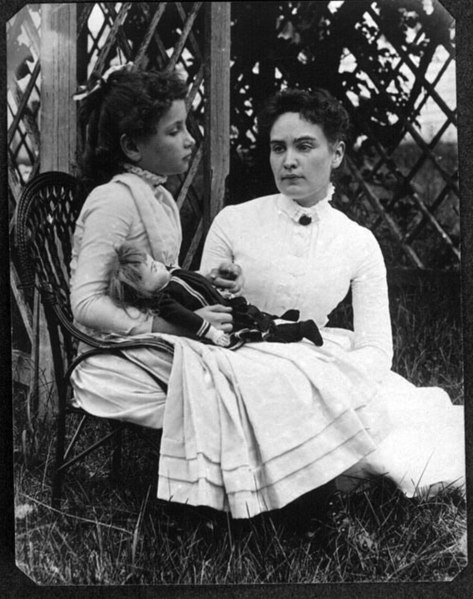 |
| Helen Keller and Anne Sullivan in 1888 |
Helen Keller's "Miracle" Takes Place, 1887
If you've ever seen the movie The Miracle Worker, you'll remember the dramatic scene when Helen first realizes that the movements Anne Sullivan is signing into her hand spell w-a-t-e-r. If you also got the idea that Helen was totally unable to communicate before this, you would be wrong. Helen had worked out about 60 signs with which she could communicate with her family.When Anne Sullivan arrived to teach Helen, she was struck by the inadequacies of Helen's "language." Sixty signs make up a pretty inadequate language. In particular, she noticed that Helen had trouble differentiating between mug, milk, and drink, using the same sign for all three. The miracle of the w-a-t-e-r day is that Helen realized that there would now be available to her a infinite number of words to represent the things in her world.
Ripple Rock Destroyed by Explosion, 1958
Ripple Rock was incredibly dangerous. In the years from 1875 until its destruction, the twin underwater mountain peaks destroyed 120 ships and claimed 114 lives. It was located in the Discovery Passage of British Columbia, and was directly in the path of a voyage from Seattle to Alaska. The peaks were only nine feet below the surface of the water and created terrible whirlpoolsPlans to destroy the peaks had been studied as early as 1931, but not everyone was in favor. Some thought that Ripple Rock would be ideal for use as a bridge support for a rail connecting Vancouver Island with the mainland. Attempts were made to destroy the mounts in 1943, and again in 1945, but failed in both cases. These attempts were staged from drilling platforms on barges above the peaks, but the turbulence of the water was too strong -- the barges broke from their anchor lines before the drilling was accomplished.
The final, successful, attempt to drill began in November 1955. This time the drilling began from nearby Maude Island. The shaft ran 570 feet straight down, then 2500 feet horizontally to the base of Ripple Rock, and then two main tunnels ran upwards for another 298 feet. From these, smaller tunnels were drilled for explosives -- 1400 tons of them, more than 10 times the amount required for an explosion of this type above water.
The resulting explosion displaced 700,000 tons of rock and water, hurling the debris at least 985 feet into the air. After the explosion, the clearance of the area at low tide was increased to 45 feet. At the time it was the largest planned non-nuclear explosion that had ever taken place. (Soviet authorities have reported a larger explosion in the Ural Mountains since then.) It was televised live on Canadian television.
The event was carefully orchestrated to coincide with a time when there were few salmon in the area. Various other animals that inhabited the area (including five orca, a school of porpoises, two sea lions, and a fur seal) were later spotted alive and unharmed.
Cold Food Festival, China
The Cold Food Festival is a holiday celebrated in China on April 5th. The legend is better than what is probably the true reason for the celebration.According to legend, a prince named Chong'er was near starvation while hiding out from neighboring warrior princes. A man named Jie Zhitui was so loyal to the prince that he cut off a strip of flesh from his thigh and offered it to Chong'er for food.
Later, when Chong'er became Duke, he searched for Jie Zhitui in order to thank him. Jie Zhitui, who now lived in the mountains with his mother, had no wish for thanks or political favors, and he refused the summons. Chong'er then ordered the mountains burned in order to force Jie Zhitui out of hiding. It didn't work: Jie Zhitui and his mother remained where they were and were killed by the fire.
Later, Chong'er was so filled with remorse at what he had done that he ordered that from that time on, all fires were forbidden during a three-day period, in honor of Jie Zhitui. The holiday is still celebrated. Activities include the visiting of ancestral tombs, cock-fighting, and the beating of blankets (as a sort of spring-cleaning.)
In actuality, the holiday probably stems from a sort of seasonal celebration. It falls during a time of year when the change from one type of wood to another would have taken place, and probably honors the use of the new type of fire-starter. It is also seen as an annual freshening and restarting of the year, and of human endeavors.
_by_Li_Tang_(%E6%9D%8E%E5%94%90)%2C_1140.jpg/800px-Duke_Wen_of_Jin_Recovering_His_State_(%E6%99%89%E6%96%87%E5%85%AC%E5%BE%A9%E5%9C%8B%E5%9C%96)_by_Li_Tang_(%E6%9D%8E%E5%94%90)%2C_1140.jpg)
No comments:
Post a Comment